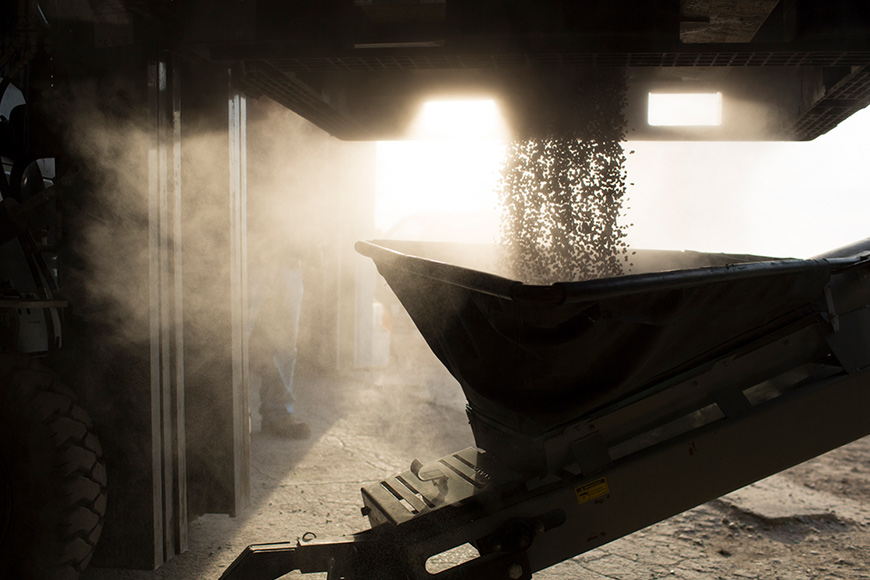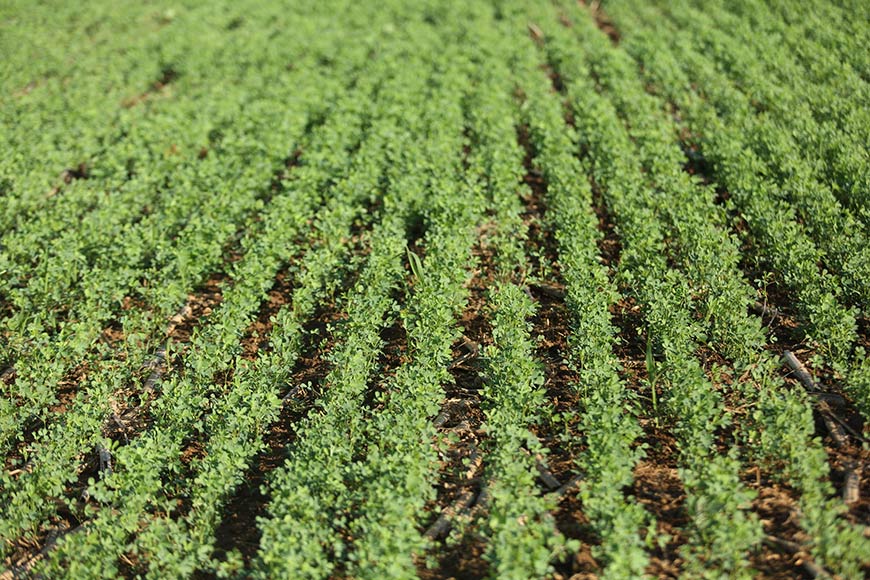Enhancing Sunflower Crop Performance: How to Go From Good to Great

As much as sunflower yield potential has grown in recent years, I firmly believe we’ve yet to reach the pinnacle of crop performance. Simply put, there are several agronomic practices producers can implement to improve their operation and turn a good crop into a great one.
When I started working with sunflowers in South Dakota about 8 or 9 years ago, a “good” crop was about 2,000 lbs./A and a “great” crop was around 2,500 lbs./A. Since then, those numbers have improved by about 20-25%; 2,500 lbs./A is considered good for sunflowers, while 3,000 lbs./A is considered great.
Thanks to a great deal of effort from our breeding partners and the WinField® United research and development team, much of the jump in performance can be attributed to enhanced sunflower genetics. The quality of CROPLAN® sunflower hybrids has steadily improved, and advances in factors like disease resistance, stalk strength and drought tolerance have enabled growers to better place products based on where they perform best.
One of the most exciting things I’ve observed about enhanced sunflower yield potential is that by improving just one or two areas of management practices you can optimize your crop and return on investment (ROI).
Problems with sunflower stand development can be a significant yield-limiting factor, so depending on the age and quality of your equipment, you might find that upgrading to new precision planting equipment may be in order. While this can be a significant expense, NDSU research indicates that improved planting technology can improve profits by about $90/A.1 So depending on how many acres you dedicate to the crop annually, the resulting improvement in yield potential has the potential to pay for itself relatively quickly.
Phosphorus (P) and potassium (K) levels are equally important. Every ton of sunflowers produced per acre require at least 50 lbs./A P and 100 lbs./A K.
Although producers typically do a good job in meeting their crop’s macronutrient needs, many are missing out on the opportunity to dial-in their sunflower fertility program by supplying important micronutrients, namely boron (B). Boron helps improve the efficiencies of many different functions within the plant. Whenever growing conditions indicate that you’ll have an average to above average crop, I recommend getting in the habit of applying boron along with your insecticide application at early flowering. Including a product like MAX-IN® Boron in your tank mix at 1 pint/A is a great way to go. Another option is to apply a dry granular 14% boron product at 5-10 lbs./A. Either application has the potential to optimize yield potential and increase your potential ROI.
Late April or early May is the best time to make this treatment, which should consist of a glyphosate product like Cornerstone® 5 Plus herbicide, plus the right tank-mix partners to help target glyphosate-resistant weeds. I recommend adding a 2,4-D ester type product like Shredder® E-99 herbicide and a dicamba product like Sterling Blue® herbicide.
Depending on the amount of weed pressure that returns after planting, you’ll want to return with a pre-emerge and post-emerge herbicide application. The key is to target weeds before they reach 4-5 inches in height, because once they get that tall, they become much harder to control.
Regardless of the weed control applications, always consult your local WinField United retailer for assistance in selecting the right application rates and adjuvant package for your operation.
However, it takes 3-5 weeks for your sunflower crop to completely pollinate. So, if you’re only spraying for bugs at the beginning of that window, you have a good opportunity to improve yield potential by making a second application, especially at current grain prices. Therefore, make it a point to continue scouting your fields for insect pressure and be ready to spray again if economic thresholds are met once 50-60% of your crop has flowered.
When spraying insecticides, I always advise mixing active ingredients whenever possible to help prevent resistance from occurring. Including the right adjuvant package in the tank can also help improve treatment efficacy.
While most producers wait to plant sunflowers until soils are 60 degrees F, quite a few farmers are planting earlier to target higher yield potential and earlier harvest. This can expose the stand to more wireworm pressure, so consider applying an in-furrow insecticide to control pests before feeding begins.
The economic threshold for Phomopsis stem canker is low, and it thrives when moisture is abundant from 10-leaf through flowering, the same growing conditions that favor strong sunflower yield potential. SDSU research indicates that products like Headline® and Priaxor® Xemium® fungicides often can help optimize yield potential and improve standability2, so I recommend planting hybrids with partial resistance to the disease and applying one of these products from 1 ½ feet tall to pre-bud (R1) to reduce the chances of a severe outbreak when you’re expecting a good crop.
Common rust can be a yield-limiting issue, so farmers should proactively apply a product like Priaxor Xemium brand fungicide on their sunflower crop. The best time for this application is when 10% of a stand has pollinated, so I recommend a 3-in-1 tank mix application of Grizzly Too insecticide, Priaxor Xemium fungicide and MAX-IN Boron. Since you’re already paying for the aerial insecticide application at early flowering, adding these partners to the mix is a great way to get the most bang for your buck.
Each of the enhanced agronomic practices I’ve described have the potential to push yield potential higher to the point where you can experience an increased ROI potential when conditions favor a strong sunflower crop. The key is to start every season with sufficient fertility levels and a robust stand. After that, read the year you’re in and let the conditions guide which in-season treatments have the most potential to improve the performance of your crop.
Customizing your management plan is often just as much of an art as it is a science, so the best way to position yourself for success is to turn to an experienced agronomist for help in making the best decisions for your acres. Contact your local WinField United retailer to get started.
1 https://www.sunflowernsa.com/uploads/21/seed.placement_ahmadi_2015.pdf
2 https://openprairie.sdstate.edu/cgi/viewcontent.cgi?article=2190&context=etd
All photos are either the property of WinField United or used with permission.
© 2022 WinField United. Important: Before use always read and follow label instructions. Crop performance is dependent on several factors many of which are beyond the control of WinField United, including without limitation, soil type, pest pressures, agronomic practices and weather conditions. Growers are encouraged to consider data from multiple locations, over multiple years and to be mindful of how such agronomic conditions could impact results. CROPLAN, Cornerstone, Delta Gold, Grizzly, MAX-IN, Preference, Section, Shredder, Sterling Blue and WinField are trademarks of WinField United. All other trademarks are the property of their respective owners.
When I started working with sunflowers in South Dakota about 8 or 9 years ago, a “good” crop was about 2,000 lbs./A and a “great” crop was around 2,500 lbs./A. Since then, those numbers have improved by about 20-25%; 2,500 lbs./A is considered good for sunflowers, while 3,000 lbs./A is considered great.
Thanks to a great deal of effort from our breeding partners and the WinField® United research and development team, much of the jump in performance can be attributed to enhanced sunflower genetics. The quality of CROPLAN® sunflower hybrids has steadily improved, and advances in factors like disease resistance, stalk strength and drought tolerance have enabled growers to better place products based on where they perform best.
One of the most exciting things I’ve observed about enhanced sunflower yield potential is that by improving just one or two areas of management practices you can optimize your crop and return on investment (ROI).
Upgrade Planter Technology
Crop seeds often weigh a planter down, but sunflower seeds are very light. This lower weight and faster travel speeds can cause planters to bounce around, resulting in inconsistent planting depths. This, of course, can lead to seed mortality and uneven sunflower stands.Problems with sunflower stand development can be a significant yield-limiting factor, so depending on the age and quality of your equipment, you might find that upgrading to new precision planting equipment may be in order. While this can be a significant expense, NDSU research indicates that improved planting technology can improve profits by about $90/A.1 So depending on how many acres you dedicate to the crop annually, the resulting improvement in yield potential has the potential to pay for itself relatively quickly.
Fine-Tune Fertility
Most producers already have a solid program in place when it comes to supplying macronutrients. Providing adequate nitrogen (N) has always been an important focus of driving sunflower yield potential, even though sunflowers don’t provide the same visual response to N as other crops. For example, you get a big, lush green plant when applying N on corn and wheat, but a sunflower plant doesn’t look much different when N levels are boosted. There is, however, a significant yield response. As a rule of thumb, at least 100 lbs./A N needs to be supplied for every ton of sunflowers produced per acre.Phosphorus (P) and potassium (K) levels are equally important. Every ton of sunflowers produced per acre require at least 50 lbs./A P and 100 lbs./A K.
Although producers typically do a good job in meeting their crop’s macronutrient needs, many are missing out on the opportunity to dial-in their sunflower fertility program by supplying important micronutrients, namely boron (B). Boron helps improve the efficiencies of many different functions within the plant. Whenever growing conditions indicate that you’ll have an average to above average crop, I recommend getting in the habit of applying boron along with your insecticide application at early flowering. Including a product like MAX-IN® Boron in your tank mix at 1 pint/A is a great way to go. Another option is to apply a dry granular 14% boron product at 5-10 lbs./A. Either application has the potential to optimize yield potential and increase your potential ROI.
Plant Into Clean Fields
The more weeds you control, the more you reduce competition for water and nutrients, inherently improving the yield potential of your crop. Kochia, marestail, cheatgrass, wild oats and perennial weeds like lambsquarters and red root pigweed are only a few of the competitors positioned to rob your crop, so it’s critical to start with a spring burndown application so you can plant into a weed-free field.Late April or early May is the best time to make this treatment, which should consist of a glyphosate product like Cornerstone® 5 Plus herbicide, plus the right tank-mix partners to help target glyphosate-resistant weeds. I recommend adding a 2,4-D ester type product like Shredder® E-99 herbicide and a dicamba product like Sterling Blue® herbicide.
Depending on the amount of weed pressure that returns after planting, you’ll want to return with a pre-emerge and post-emerge herbicide application. The key is to target weeds before they reach 4-5 inches in height, because once they get that tall, they become much harder to control.
Regardless of the weed control applications, always consult your local WinField United retailer for assistance in selecting the right application rates and adjuvant package for your operation.
Beat Pests to the Punch
Well-timed insecticide applications have probably led to the most dramatic increase in sunflower yield potential in recent years. Most farmers do a good job spraying when their crop reaches 10% pollination, which you can usually detect from the road. Once your green fields start to exhibit a light yellow tinge when driving by at 65 mph, you know it’s time to spray. Products like Grizzly® Too and Delta Gold® insecticides provide 7-10 days of effective residual control of pests like banded sunflower moth, red sunflower seed weevil and lygus bug.However, it takes 3-5 weeks for your sunflower crop to completely pollinate. So, if you’re only spraying for bugs at the beginning of that window, you have a good opportunity to improve yield potential by making a second application, especially at current grain prices. Therefore, make it a point to continue scouting your fields for insect pressure and be ready to spray again if economic thresholds are met once 50-60% of your crop has flowered.
When spraying insecticides, I always advise mixing active ingredients whenever possible to help prevent resistance from occurring. Including the right adjuvant package in the tank can also help improve treatment efficacy.
While most producers wait to plant sunflowers until soils are 60 degrees F, quite a few farmers are planting earlier to target higher yield potential and earlier harvest. This can expose the stand to more wireworm pressure, so consider applying an in-furrow insecticide to control pests before feeding begins.
Prevent Disease Pressure
Although downy mildew is a major threat in and around the Dakotas, fortunately most sunflower hybrids come with protection via fungicide seed treatments or downy mildew resistance traits. Therefore, diseases like Phomopsis stem canker and common rust are the ones to focus on controlling during the growing season.The economic threshold for Phomopsis stem canker is low, and it thrives when moisture is abundant from 10-leaf through flowering, the same growing conditions that favor strong sunflower yield potential. SDSU research indicates that products like Headline® and Priaxor® Xemium® fungicides often can help optimize yield potential and improve standability2, so I recommend planting hybrids with partial resistance to the disease and applying one of these products from 1 ½ feet tall to pre-bud (R1) to reduce the chances of a severe outbreak when you’re expecting a good crop.
Common rust can be a yield-limiting issue, so farmers should proactively apply a product like Priaxor Xemium brand fungicide on their sunflower crop. The best time for this application is when 10% of a stand has pollinated, so I recommend a 3-in-1 tank mix application of Grizzly Too insecticide, Priaxor Xemium fungicide and MAX-IN Boron. Since you’re already paying for the aerial insecticide application at early flowering, adding these partners to the mix is a great way to get the most bang for your buck.
Each of the enhanced agronomic practices I’ve described have the potential to push yield potential higher to the point where you can experience an increased ROI potential when conditions favor a strong sunflower crop. The key is to start every season with sufficient fertility levels and a robust stand. After that, read the year you’re in and let the conditions guide which in-season treatments have the most potential to improve the performance of your crop.
Customizing your management plan is often just as much of an art as it is a science, so the best way to position yourself for success is to turn to an experienced agronomist for help in making the best decisions for your acres. Contact your local WinField United retailer to get started.
1 https://www.sunflowernsa.com/uploads/21/seed.placement_ahmadi_2015.pdf
2 https://openprairie.sdstate.edu/cgi/viewcontent.cgi?article=2190&context=etd
All photos are either the property of WinField United or used with permission.
© 2022 WinField United. Important: Before use always read and follow label instructions. Crop performance is dependent on several factors many of which are beyond the control of WinField United, including without limitation, soil type, pest pressures, agronomic practices and weather conditions. Growers are encouraged to consider data from multiple locations, over multiple years and to be mindful of how such agronomic conditions could impact results. CROPLAN, Cornerstone, Delta Gold, Grizzly, MAX-IN, Preference, Section, Shredder, Sterling Blue and WinField are trademarks of WinField United. All other trademarks are the property of their respective owners.





